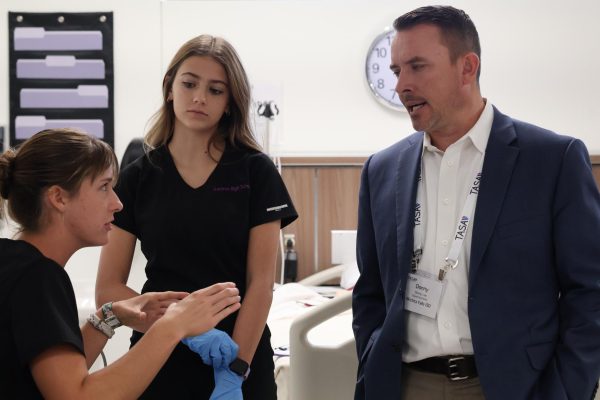Dark skin, darker consequences
As prom season approaches, girls flock to the nearest electric sources of sunlight day after day to cook their skin until the maximum peak of darkness is reached before the summer months arrive. The mental image of a bronze skin tone unfortunately overshadows the detrimental risk of a potentially fatal skin disease.
Before lying in a tanning bed, tanners should consider the serious health risks that they could encounter.
An even more alarming fact, people who first use a tanning bed before age 35 increase their risk for melanoma by 75 percent.
— Cortlyn Dees
Ultraviolent radiation is a proven human carcinogen, which means it causes cancer. Ultraviolent radiation has three types of wavelengths: UVA, UVB and UVC. UVA rays age cells and can damage cells’ DNA. They are linked to long-term skin damage, such as wrinkles, and also play a role in some skin cancers. According to the Skin Cancer Foundation, frequent tanners may receive as much as 12 times the annual UVA dose compared to the dose they receive from sun exposure. Tanning beds have been associated with basal cell, squamous cell and malignant melanoma. The most serious of these is melanoma because it can be deadly if detected too late. The Skin Cancer Foundation also wrote that just one indoor tanning session increases users’ chances of developing melanoma by 20 percent, and each additional session during the same year boosts the risk almost another two percent. An even more alarming fact, people who first use a tanning bed before age 35 increase their risk for melanoma by 75 percent. Over the past 40 years, rates of melanoma diagnosis increased by 800 percent among young women and 400 percent among young men. One person dies of melanoma every hour. A darkened skin tone is not worth that.
Skin cancer is not the only side effect that can occur due to tanning beds. The American Academy of Dermatology wrote that people who work or lay in the sun without sufficient protection get a tough, leathery skin that can make them look much older. Too much sun exposure causes the elasticity in skin to diminish and can result in sagging cheeks and deep wrinkles. The sun can also cause unsightly red, yellow, gray or brown spots. The sun can also cause cataracts and other eye damage. Cataracts are one of the leading causes of blindness.
The national average cost for one month at a tanning bed can range between $30 and $50. In addition to the $50 price tag on a tanning bed, Americans spend $426 million per year on nonmelanoma skin care treatment. For every dollar spent on a tanning bed, users will spend ten dollars receiving treatment in a physician’s office for nonmelanoma skin cancer. A price cannot be put on a person’s life.
Tanning bed salons want clients to believe that they are harmless, and, unless they experience burning, tanning is painless. But, local dermatologist Dr. Larry Roberts explained that the damage done by tanning beds is accumulative and, in some cases, may not be visible for years. Roberts said the UVA rays emitted by the tanning bed go deeper into the skin, creating an underlying layer of damage. Some argue that tanning beds can give users a greater Vitamin D intake, but supplements that are just as effective can be taken. Another myth is that going to a tanning bed will help protect your skin from sunburns. The American Academy of Dermatology said a tan does not prevent sun damage, it is sun damage. Roberts said that melanin acts like an umbrella to protect the skin cells nucleus from damage, and that tanning is a cascade of events that make cells produce more melanin. Roberts added that tanning is a protective response of your body, but that it doesn’t protect you as much as sunscreen would.
There are plenty of alternative to achieving a darker skin tone that don’t involve harmful radiation. Our local Walmart carries a variety of ten brands of sunless tanning products ranging in price between six and nine dollars. For a temporarily darker skin tone, La Bella Beauty Salon charges between $25 and $30 for spray tans depending on whether or not you apply a moisturizer during the tan. Either option is much safer than going to a tanning bed.
One in five Americans will develop skin cancer in the course of a lifetime. Don’t let yourself become a statistic.

My name is Cortlyn Dees and this year I am Co-Editor-In-Chief of The Eagle’s Tale, alongside Kori Adair. I am a senior, and this is my second year as a varsity cheerleader. I am a member of National Honor Society, American Sign Language Honors Society,...





